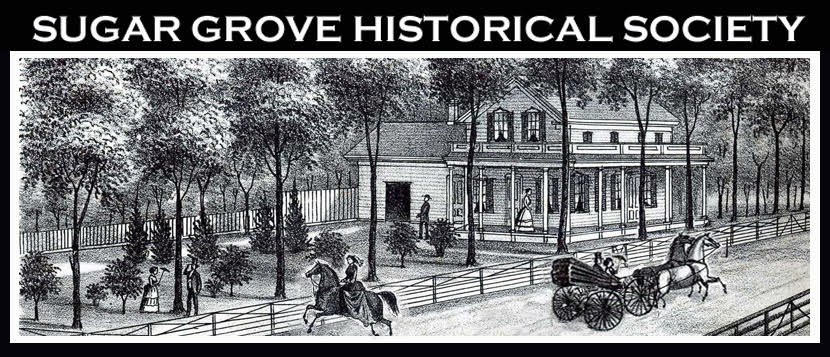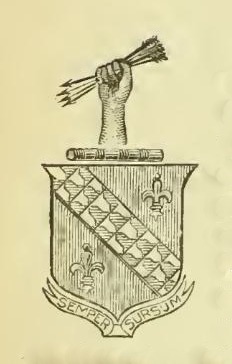Dublin Core
Title
Bliss Family Coat of Arms
Subject
[no text]
Description
“Coats of Arms were long regarded as ‘indispensable appendages of gentlemen,’ but on the decline of feudal system, about 1688, and the rise of the Reformation, they were treated in a measure as idle trappings of aristocracy, and lost the prestige originally attributed to them. In America they soon came to be regarded as ‘relics of former family vanity;’ and the staunch old Puritans would not allow themselves to tolerate even a thought that could remind them of the vain-glorious display and pomp of their persecutors in England; and so their children and descendants born in America grew up in ignorance of the heraldic standing of their ancestors in the mother country.
“In Edmondson’s Heraldry, and also in Vol. II of ‘Encyclopedia Heralidica,’ by William Berry, of London, England, we find the following description of the Coat of Arms of the Bliss family:
“ ‘ Gules, a bend vaire, between two fleurs-de-lis, or.’ “
“ As to the construction of this shield, it appears that gules (red) is a royal color, as Gerard Leigh says, ‘it hath long been used by emperors and kings for an apparel of majesty, and of judges in their judgment seats.’ Spelman observes that the color red was honored by the Romans as it had been before by the Trojans, for they painted their gods with vermillion, and clothed their generals who triumphed, with garments of that hue. This color denotes martial prowess, boldness, hardihood, valor and magnanimity; it is considered the noblest of all colors, and in Heraldry is assimilated to the planet Mars in the heavens, to the ruby among stones, and among flowers to the rose.
“The origin of vair (or vaire) is from the fur of a beast called varus, [MACKENZIE, p. 23] whose back is a blue-gray, its belly being white, and therefore heralds have expressed it white and blue in colors; and when the head and feet of the animal are taken away, the skin resembles in figure a little cup or bell. The skins are used alternately blue and white, and in ancient times were much in vogue for lining the robes and mantles of senators, consuls, kings and emperors, and thereupon were termed ‘doublings.’ The first use of them in Heraldry is said to be from LE SEGNEUR DE COUCIES, fighting in Hungary, and seeing his army fly, pulled out the doubling or lining of his cloak, which was of those colors, and hung it up as an ensign; whereupon the soldiers knowing his courage and confiding in it, returned to battle and overcame their enemy. – [COLOMB., p. 58.]
The fleur-de-lis has been from the first bearing the charge of a regal escutcheon originally borne by the French kings, and was until late in the nineteenth century the insignia of royalty in France. The lily, which of all flowers is most esteemed by the French, has been of old and still is represented by a rudely drawn fleur-de-lis. As before stated, it was the heraldic device or emblem of the royal family of France, and was so borne form the time of Clovis until the accession of Louis Phillippe; -- and whether this badge came to our family by royal descent or by royal favor, we are unable to judge.
“In English Heraldry different marks of cadency were used to indicate the various branches or cadets of one family; - the oldest son, during the life of his father, bore a ‘label;’ the second son a crescent; the third a mullet; the fourth a martlet; the fifth an annulet; and the sixth a fleur-de-lis. Thus it would appear that the original grant of arms to a Bliss, by whoever given, (if in England,) was to a sixth son. Some writers have fancied that a significant symbol might be drawn from the fleur-de-lis as to the flowers of literature which younger sons were led to cultivate in the schools to fit them for the church, the senate, and the bar; but Newton thinks the adaptation was originally intended to be only personal, and accident in arms, exhibiting the degree of consanguinity of the bearer to the living head of the family.
“Or, (gold) – ‘Such is the worthiness of this color that non ought to bear the same in arms but emperors and kings, and such as be of the blood royal; and as this metal exceedeth all others in value, purity and fineness, so ought the bearer endeavor to surpass all others in prowess and virtue.’ – GUILLIM."
“The significance and appropriateness of the crest will be fully understood after a perusal of the Traditional History of the family.
“The motto, ‘SEMPER SURSUM,’ translated, means, ‘ever upward,’ and signifies that the bearer should always endeavor to excel in his undertakings, aiming at goodness rather than greatness, in every deed or motive.”
“In Edmondson’s Heraldry, and also in Vol. II of ‘Encyclopedia Heralidica,’ by William Berry, of London, England, we find the following description of the Coat of Arms of the Bliss family:
“ ‘ Gules, a bend vaire, between two fleurs-de-lis, or.’ “
“ As to the construction of this shield, it appears that gules (red) is a royal color, as Gerard Leigh says, ‘it hath long been used by emperors and kings for an apparel of majesty, and of judges in their judgment seats.’ Spelman observes that the color red was honored by the Romans as it had been before by the Trojans, for they painted their gods with vermillion, and clothed their generals who triumphed, with garments of that hue. This color denotes martial prowess, boldness, hardihood, valor and magnanimity; it is considered the noblest of all colors, and in Heraldry is assimilated to the planet Mars in the heavens, to the ruby among stones, and among flowers to the rose.
“The origin of vair (or vaire) is from the fur of a beast called varus, [MACKENZIE, p. 23] whose back is a blue-gray, its belly being white, and therefore heralds have expressed it white and blue in colors; and when the head and feet of the animal are taken away, the skin resembles in figure a little cup or bell. The skins are used alternately blue and white, and in ancient times were much in vogue for lining the robes and mantles of senators, consuls, kings and emperors, and thereupon were termed ‘doublings.’ The first use of them in Heraldry is said to be from LE SEGNEUR DE COUCIES, fighting in Hungary, and seeing his army fly, pulled out the doubling or lining of his cloak, which was of those colors, and hung it up as an ensign; whereupon the soldiers knowing his courage and confiding in it, returned to battle and overcame their enemy. – [COLOMB., p. 58.]
The fleur-de-lis has been from the first bearing the charge of a regal escutcheon originally borne by the French kings, and was until late in the nineteenth century the insignia of royalty in France. The lily, which of all flowers is most esteemed by the French, has been of old and still is represented by a rudely drawn fleur-de-lis. As before stated, it was the heraldic device or emblem of the royal family of France, and was so borne form the time of Clovis until the accession of Louis Phillippe; -- and whether this badge came to our family by royal descent or by royal favor, we are unable to judge.
“In English Heraldry different marks of cadency were used to indicate the various branches or cadets of one family; - the oldest son, during the life of his father, bore a ‘label;’ the second son a crescent; the third a mullet; the fourth a martlet; the fifth an annulet; and the sixth a fleur-de-lis. Thus it would appear that the original grant of arms to a Bliss, by whoever given, (if in England,) was to a sixth son. Some writers have fancied that a significant symbol might be drawn from the fleur-de-lis as to the flowers of literature which younger sons were led to cultivate in the schools to fit them for the church, the senate, and the bar; but Newton thinks the adaptation was originally intended to be only personal, and accident in arms, exhibiting the degree of consanguinity of the bearer to the living head of the family.
“Or, (gold) – ‘Such is the worthiness of this color that non ought to bear the same in arms but emperors and kings, and such as be of the blood royal; and as this metal exceedeth all others in value, purity and fineness, so ought the bearer endeavor to surpass all others in prowess and virtue.’ – GUILLIM."
“The significance and appropriateness of the crest will be fully understood after a perusal of the Traditional History of the family.
“The motto, ‘SEMPER SURSUM,’ translated, means, ‘ever upward,’ and signifies that the bearer should always endeavor to excel in his undertakings, aiming at goodness rather than greatness, in every deed or motive.”
Identifier
[no text]
Date
January 1, 1881
Creator
[no text]
Language
[no text]
Rights
[no text]
Format
[no text]
Relation
[no text]
Source
Genealogy of the Bliss family in America, from about the year 1550 – 1880 by John Homer Bliss, January 1, 1881, pages 14-15.
Publisher
[no text]
Contributor
[no text]
Type
[no text]
Coverage
[no text]
Still Image Item Type Metadata
Original Format
[no text]
Physical Dimensions
[no text]

